Prehistoric Ireland
Prehistoric Ireland is in Prehistoric British Isles.
Europe, British Isles, Ireland, Province of Ulster, County Down, Newry, Killevy, Ballymacdermot Court Tomb [Map]![]()
Archaeologia Volume 15 Appendix. March 14th, 1804. The Rev. the Dean of Raphoe presented to the Society four original drawings of some caves [Ballymacdermot Court Tomb [Map]], which he had discovered on his glebe, in the parish of Killevy, in the county of Armagh in Ireland. Some account of these caves, with engravings, has been published by General Vallencey, in his Collectanea de Rebus Hibernicis; yet, for the satisfaction of such gentlemen as may not have seen that publication, the Dean accompanied his present with a short description, as follows:
Europe, British Isles, Ireland, Province of Leinster, County Meath, Boyne Valley, Dowth Passage Tomb [Map]![]()
Llewellynn Jewitt 1870. At Dowth [Map] and Nowth [Map] (Dubhath and Cnobh), very similar chambered tumuli exist, the former of which is also remarkable for its sculptural stones, which bear a strong resemblance to those at New Grange. The Cairn of Dowth here engraved (fig. 45), is of immense size, and contains a cruciform chamber similar to that at New Grange, with a passage twenty-seven feet in length, composed as was the chamber of enormous stones. On some of the stones were carvings and Oghams. The mouth of the passage leading to the cruciform chamber is shown on fig. 46.
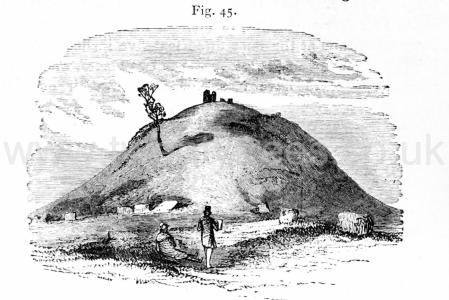
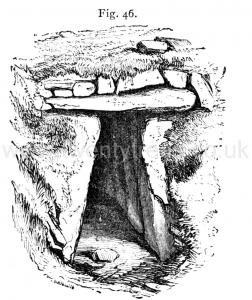
Europe, British Isles, Ireland, Province of Munster, County Waterford, Drumloghan Burial Chamber [Map]![]()
Llewellynn Jewitt 1870. Other excellent examples of Irish cromlechs and chambers are those at Monasterboise ("Calliagh Dirras House") [Map]; Drumloghan (full of Oghams) [Map]; Kells; Knockeen [Map] (figs. 47 and 48); where the right supporting stones are six in number, and arranged rectangularly, so as to form a distinct chamber at the S.E. end, the large covering stone being 12 feet inches by 8 feet, and weighing about four tons, and the smaller one about half that size; Gaulstown [Map] (figs. 49 and 50, the inner chamber of which measures 7 feet by 6 feet 4 inches, and is seven feet in height); Ballynageerah (figs. 51, 52, and 53), the capstone of which is cleverly and curiously poised on two only of the upright stones, as will be seen by the engravings1; Howth, Shandanagh, Brennanstown, Glencullen, Kilternan, Mount Brown, Rath-kenny, Mount Venus, and Knock Mary, Phoenix Park, as well as at many omer places.
Note 1. For the loan of these seven engravings I am indebted to the Council of the "Historical and Archaeological Association of Ireland," (formerly the "Kilkenny and South-east of Ireland Archaeo'ogical Society,") in whose journal one of the most valuable of antiquarian publications they have appeared. This Association is one of the most useful that has ever been established, and deserves the best support, not only of Irish, but of English antiquaries.
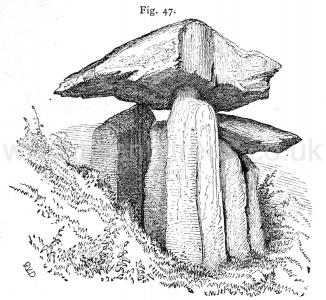
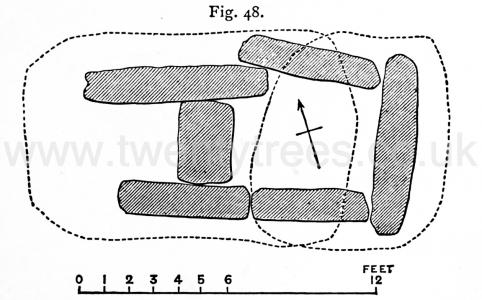
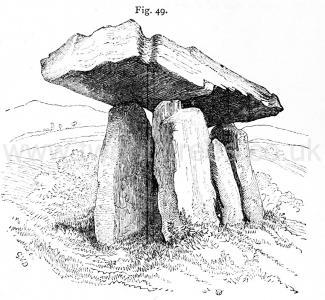
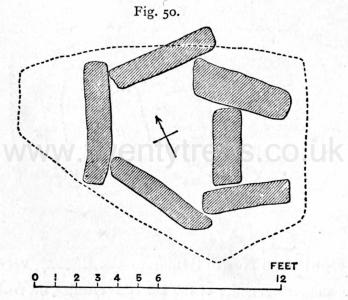
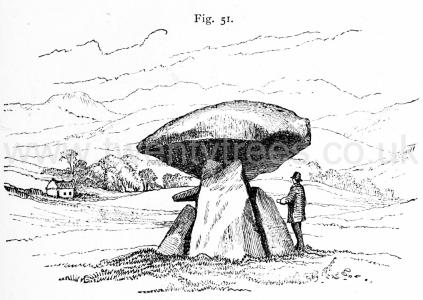
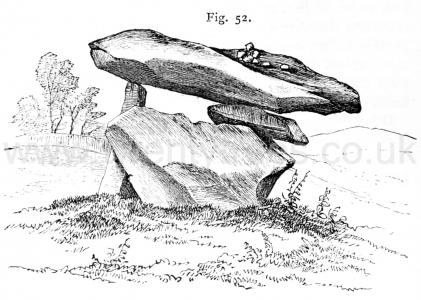
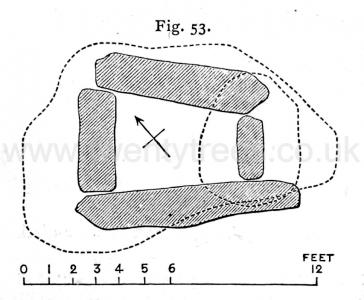
Europe, British Isles, Ireland, Province of Munster, County Waterford, Gaulstown Portal Tomb [Map]![]()
Llewellynn Jewitt 1870. Other excellent examples of Irish cromlechs and chambers are those at Monasterboise ("Calliagh Dirras House") [Map]; Drumloghan (full of Oghams) [Map]; Kells; Knockeen [Map] (figs. 47 and 48); where the right supporting stones are six in number, and arranged rectangularly, so as to form a distinct chamber at the S.E. end, the large covering stone being 12 feet inches by 8 feet, and weighing about four tons, and the smaller one about half that size; Gaulstown [Map] (figs. 49 and 50, the inner chamber of which measures 7 feet by 6 feet 4 inches, and is seven feet in height); Ballynageerah (figs. 51, 52, and 53), the capstone of which is cleverly and curiously poised on two only of the upright stones, as will be seen by the engravings1; Howth, Shandanagh, Brennanstown, Glencullen, Kilternan, Mount Brown, Rath-kenny, Mount Venus, and Knock Mary, Phoenix Park, as well as at many omer places.
Note 1. For the loan of these seven engravings I am indebted to the Council of the "Historical and Archaeological Association of Ireland," (formerly the "Kilkenny and South-east of Ireland Archaeo'ogical Society,") in whose journal one of the most valuable of antiquarian publications they have appeared. This Association is one of the most useful that has ever been established, and deserves the best support, not only of Irish, but of English antiquaries.







Europe, British Isles, Ireland, Province of Leinster, County Kilkenny, Kilmogue Portal Tomb [Map]![]()
Archaeologia Volume 16 Section XXVIII. Description of a Crom-Leach [Kilmogue Portal Tomb [Map]], in the County of Kilkenny, By Mr. Joseph Thomas Finegan. Communicated by The Marquess Townshend (age 33), and Earl of Leicester, President. Read 30th April, J SOJ.
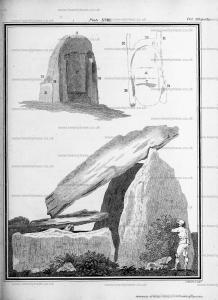
Europe, British Isles, Ireland, Province of Munster, County Waterford, Knockeen Portal Tomb [Map]![]()
Llewellynn Jewitt 1870. Other excellent examples of Irish cromlechs and chambers are those at Monasterboise ("Calliagh Dirras House") [Map]; Drumloghan (full of Oghams) [Map]; Kells; Knockeen [Map] (figs. 47 and 48); where the right supporting stones are six in number, and arranged rectangularly, so as to form a distinct chamber at the S.E. end, the large covering stone being 12 feet inches by 8 feet, and weighing about four tons, and the smaller one about half that size; Gaulstown [Map] (figs. 49 and 50, the inner chamber of which measures 7 feet by 6 feet 4 inches, and is seven feet in height); Ballynageerah (figs. 51, 52, and 53), the capstone of which is cleverly and curiously poised on two only of the upright stones, as will be seen by the engravings1; Howth, Shandanagh, Brennanstown, Glencullen, Kilternan, Mount Brown, Rath-kenny, Mount Venus, and Knock Mary, Phoenix Park, as well as at many omer places.
Note 1. For the loan of these seven engravings I am indebted to the Council of the "Historical and Archaeological Association of Ireland," (formerly the "Kilkenny and South-east of Ireland Archaeo'ogical Society,") in whose journal one of the most valuable of antiquarian publications they have appeared. This Association is one of the most useful that has ever been established, and deserves the best support, not only of Irish, but of English antiquaries.







Europe, British Isles, Ireland, Province of Leinster, County Meath, Boyne Valley, Knowth Passage Tomb [Map]![]()
Llewellynn Jewitt 1870. At Dowth [Map] and Nowth [Map] (Dubhath and Cnobh), very similar chambered tumuli exist, the former of which is also remarkable for its sculptural stones, which bear a strong resemblance to those at New Grange. The Cairn of Dowth here engraved (fig. 45), is of immense size, and contains a cruciform chamber similar to that at New Grange, with a passage twenty-seven feet in length, composed as was the chamber of enormous stones. On some of the stones were carvings and Oghams. The mouth of the passage leading to the cruciform chamber is shown on fig. 46.


Europe, British Isles, Ireland, Province of Leinster, County Meath, Boyne Valley, Newgrange Passage Tomb [Map]![]()
Annals of Ulster 534. 534 The drowning of Muirchertach Mac Erca i.e. Muirchertach son of Muiredach son of Eógan son of Niall Naígiallach in a vat full of wine on the hilltop of Cleitech [Map] above Bóinn.
In 534 Muirchertach mac Muiredaig High King of Ireland was drowned in a butt of wine. The Annals of Ulster report ... The drowning of Muirchertach mac Muiredaig High King of Ireland in a vat full of wine on the hilltop of Cleitech above Bóinn ie at Newgrange Passage Tomb [Map].
Mona Antiqua Restauranta 310 Letters. I also met with one monument in this kingdom very singular. It stands at a place called New-Grange near Drogheda [Map]; and is a mount or barrow of very considerable height, encompassed with vast stones pitched on end round the bottom of it; and having another lesser standing on the top. This mount is all the work of hands, and consists almost wholly of stones; but is covered with gravel and green swerd, and has within it a remarkable cave. The entry into this cave is at bottom, and before it we found a great flat slone, like a large tombstone, placed edgewise, having on the outside certain barbarous carvings, like snakes encircled, but without heads. The entry was guarded all along on each side with such rude slones, pitched on end, some of them having the same carving, and other vast ones laid a-cross these at top. The out-pillars were so close pressed by the weight of the mount, that they admitted but just creeping in, but by degrees the passage grew wider and higher till we came to the cave, which was about five or fix yards high. The cave consists of three cells or apartments, one on each hand, and the third straight forward, and may be about seven yards over each way. In the right-hand cell stands a great bason of an irregular oval figure of one entire stone, having its brim oddly sinuated or elbowed in and out; and that bason in another of much the same form. Within this bason was some very clear water which dropped from the cave above, which made me imagine the use of this bason was for receiving such water, and that the use of the lower was to receive the water of the upper bason when full, for some sacred use, and therefore not to be spilled. In the left apartment there was such another bason, but single, neither was there any water in it. In the apartment straight forward there was no bason at all. Many of the pillars about the right-hand bafon were carved as the stones above-mentioned; but under feet there was nothing but loose stones of any size in confusion; and amongst them a great many bones of beads and some pieces of deers horns. Near the top of this mount they found a gold coin of the emperor Valentinian; but notwithstanding this, the rude carving above-mentioned makes me conclude this monument was never Roman, not to mention that we want history to prove that ever the Romans were at all in Ireland.
Archaeologia Volume 2 Section XXXV. In PI. XX. the figure B gives the plan of the base [of Newgrange Passage Tomb [Map]] drawn according to Mr. Bouie’s stations in measuring it; but you must understand, that the periphery of the real figure is curvilinear, not rectilinear. This base covers about two acres of ground. C is the plan of the cave and of the gallery leading to it; as it bears 240 N. W. D is the section of the pyramid, and of the ground on which it stands projected from a medium of the various numbers I have received. The whole is laid down by a scale of 84 feet to an inch.
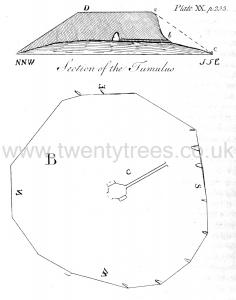
Archaeologia Volume 2 Section XXXV. 21 Jun 1770. A Description of the Sepulchral Monument at New Grange [Map], near Drogheda, in the County of Meath, in Ireland. by Thomas Pownall, Esq; in a Letter to the Rev. Gregory Sharpe, D. D. Master of The Temple. Read at the Society of Antiquaries, June 21, 28, 1770.
Llewellynn Jewitt 1870. One of the most important in size, as well as in general interest, is the one at New Grange [Map], county Meath. "The cairn, which even in its present ruinous condition measures about seventy feet in height, and is nearly three hundred feet in diameter, from a little distance presents the appearance of a grassy hill, partly wooded; but upon examination the coating of earth is found to be altogether superficial, and in several places the stones, of which the hill is entirely composed, are laid bare. A circle of enormous stones, of which eleven remain above ground1, originally encircled its base. The opening (of which an engraving is shown on fig. 44) was accidentally discovered about the year 1699, by labouring men employed in the removal of stones for the repair of a road. The gallery, of which it is the external entrance, extends in a direction nearly north and south, and communicates with a chamber, or cave, nearly in the centre of the mound. This gallery, which measures in length about fifty feet, is at its entrance from the exterior about four feet in height, in breadth at the top three feet two inches, and at the base three feet, five inches. These dimensions it retains, except in one or two places, where the stones appear to have been forced from their original position, for a distance of twenty-one feet from the external entrance. Thence towards the interior its sides gradually increase, and its height where it forms the chamber is eighteen feet. Enormous blocks of stone, apparently water-worn, and supposed to have been brought from the mouth of the Boyne, form the sides of the passage; and it is roofed with similar stones. The ground plan of the chamber is cruciform; the head and arms of the cross being formed by three recesses, one placed directly fronting the entrance, the others east and west, and each containing a basin of granite. The sides of these recesses are composed of immense blocks of stone, several of which bear a great variety of carvings2. In front of the entrance (fig. 44) will be seen one of these carved stones.
Note 1. These immense monoliths have originally, it is estimated, been upwards of thirty in number, and to have been placed probably ten yards apart. The largest remaining stone stands between eight and nine feet above the ground, and is seventeen feet in circumference. It is estimated to weigh upwards of seven tons. Several of the stones have entirely disappeared, of others fragments remain scattered about.
For an excellent notice of this and other remains, the reader is referred to Mr. W. F. Wakeman's "Handbook of Irish Antiquities," the best and most compact littlework on the subject which has been issued, and one which will be found extremely useful to the archaeological student to which I am indebted for some of the accompanying engravings.
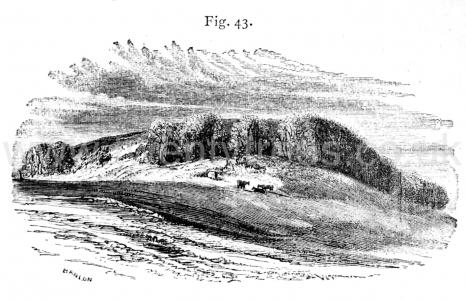
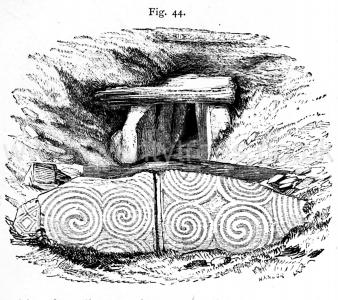
Europe, British Isles, Ireland, Province of Ulster, County Armagh, Slieve Gullion Passage Tomb [Map]![]()
Between 3500BC and 2900BC. Slieve Gullion Passage Tomb [Map] is a restored Neolithic Passage Tomb on top of Slieve Gullion mountain; said to be the highest Passage Tomb in Ireland. The entrance is aligned with the setting sun on the winter solstice. Radiocarbon dating suggests it was built c.3500–2900